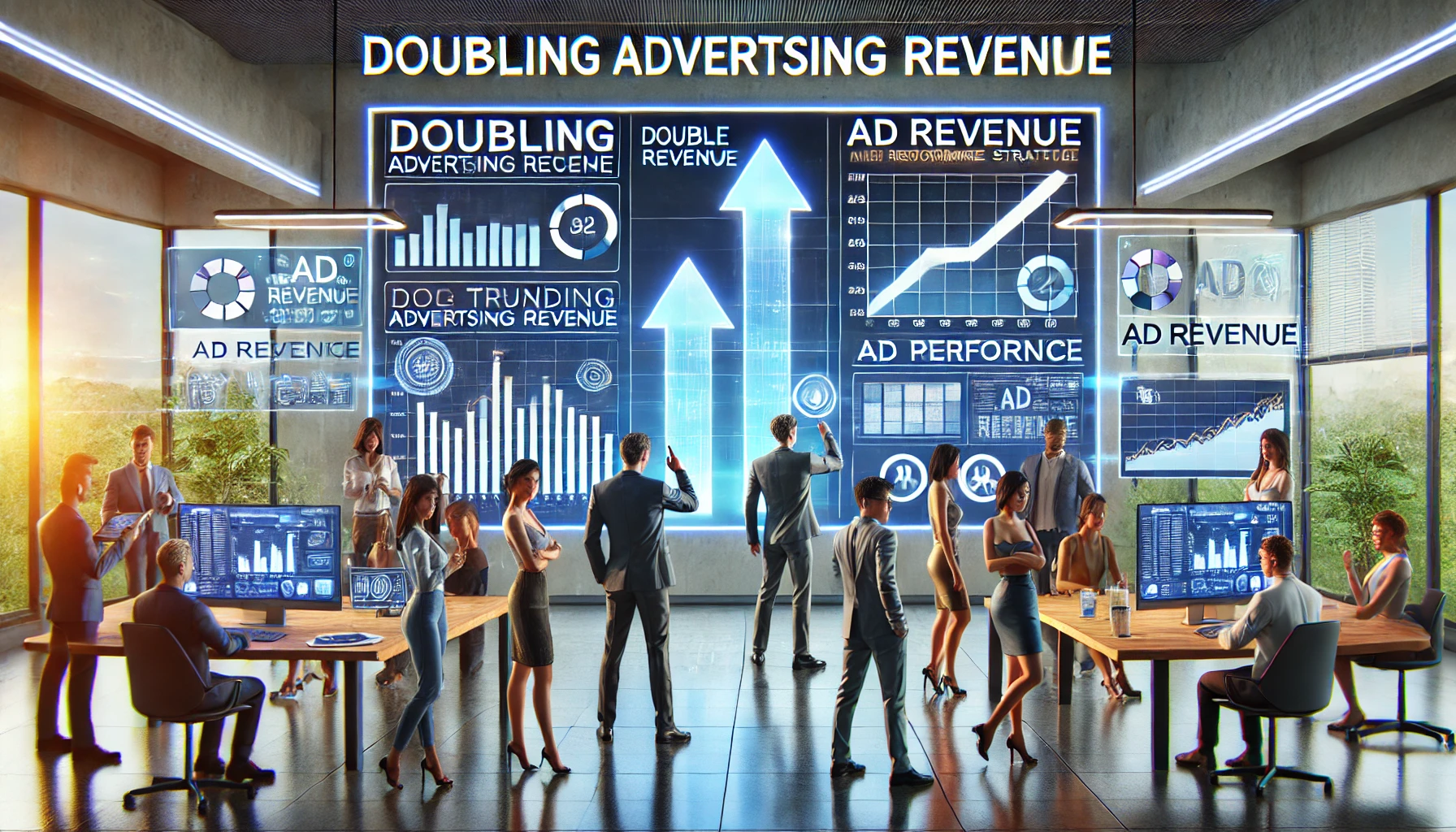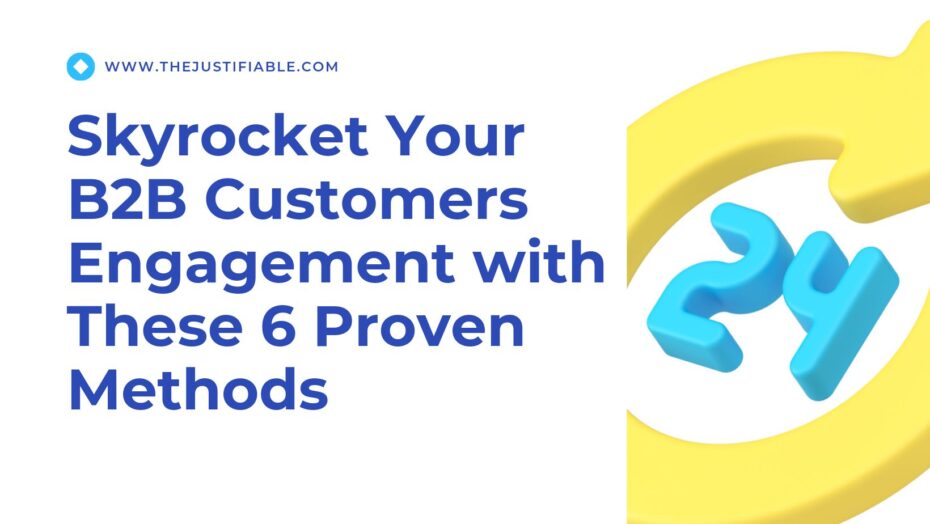Table of Contents
Are you struggling to maximize your advertising revenue and wondering if there’s a proven way to double it this year? What if you could fine-tune your strategies, attract the right audience, and make your ads work smarter, not harder?
In this guide, we’ll break down actionable steps to help you boost your advertising revenue, whether you’re a small business, content creator, or marketer. From optimizing your ad placements to leveraging automation and data-driven insights, you’ll discover practical techniques that can significantly increase your earnings.
Ready to transform your ad strategy and achieve your revenue goals? Let’s dive in!
Understanding the Basics of Advertising Revenue
Advertising revenue is the lifeblood of many businesses, offering a sustainable way to generate income while providing value to your audience. Understanding the fundamental principles behind advertising revenue can set the stage for long-term growth and unlock new opportunities to scale your earnings.
What Is Advertising Revenue and Why Does It Matter?
Advertising revenue refers to the income generated from ad placements on your platform, whether it’s a website, social media page, or app. It’s the financial backbone for many businesses and creators, allowing them to monetize traffic and content.
For example, if you’re running a blog, you might earn advertising revenue from display ads, sponsored content, or affiliate partnerships. The importance of this revenue stream lies in its scalability—it grows as your audience grows, creating a self-reinforcing cycle.
To put it into perspective, advertising revenue isn’t just about earning money; it’s about creating a win-win scenario. Advertisers gain visibility, your audience gets exposed to relevant products or services, and you enjoy the financial benefits. By understanding its significance, you can align your strategy to maximize its potential.
Key Factors That Influence Advertising Revenue Growth
Growing your advertising revenue isn’t just about increasing ad volume—it’s about optimizing multiple interconnected factors that drive success. Here are the key ones:
- Audience Size and Engagement: The more engaged your audience, the higher your revenue potential. Advertisers value platforms where users actively interact with content.
- Ad Placement and Format: Strategic placement of ads—such as above the fold or within content—can boost visibility and click-through rates. Experimenting with formats, such as video ads or native ads, can also improve results.
- Niche and Relevance: Advertisers often pay higher rates for niche audiences. For instance, a tech blog might attract premium advertisers compared to a general lifestyle site.
- Platform Analytics: Tools like Google Analytics or heatmaps reveal user behavior. These insights allow you to refine your ad strategy by understanding which areas of your platform receive the most attention.
Actionable Tip: Use A/B testing to refine ad placements and identify what resonates best with your audience.
Common Challenges in Increasing Advertising Revenue
If you’ve been trying to grow your advertising revenue but haven’t seen results, you’re not alone. Many businesses face similar hurdles. Let’s break down the most common challenges:
- Ad Blindness: Many users ignore ads because they’re either too repetitive or poorly placed.
- Low Traffic Volume: A small audience means fewer ad impressions and clicks. Even the best ad placements can’t overcome limited traffic.
- Competition: In crowded markets, advertisers have more choices, making it harder to command premium rates.
- Ad Fatigue: Bombarding users with too many ads can lead to disengagement and a decrease in revenue over time.
- Poor Optimization: Without regular monitoring and optimization, ad strategies can become stale, reducing their effectiveness.
Solution: Overcome these challenges by continuously experimenting and tracking performance metrics. Tools like Google Ad Manager or Taboola can streamline optimization efforts.
Assessing Your Current Advertising Performance

Before you can double your advertising revenue, you need to understand where you currently stand. Taking a close look at your existing performance will reveal what’s working, what’s not, and where you can make meaningful improvements.
How to Analyze Current Revenue Streams Effectively
Analyzing your current revenue streams is the foundation for growth. Without knowing where your income originates and how each stream is performing, you risk putting effort into areas that may not yield results.
Start with a breakdown of your advertising channels. For instance, are you earning primarily from display ads, affiliate links, or sponsorships? Each source needs to be evaluated individually. Tools like Google Analytics or your ad platform’s dashboard can provide clear data about impressions, click-through rates (CTR), and conversion rates.
Think of it this way: if one revenue stream consistently outperforms others, it’s a sign that it holds the potential for scaling. For example, if affiliate marketing generates 60% of your revenue but only represents 40% of your focus, there’s room to double down on that strategy.
Once you identify your top-performing streams, dig deeper into underperformers. Low CTRs or low-quality leads could signal poorly targeted ads or irrelevant placements. Resolving these inefficiencies can significantly boost overall earnings.
Identifying Gaps and Opportunities in Ad Placements
Sometimes, revenue loss isn’t about poor ads—it’s about where and how they appear. Effective ad placement balances visibility and user experience while avoiding “ad fatigue,” where users ignore ads altogether.
Evaluate your website or app layout. Are your ads positioned where users naturally look? Eye-tracking studies show that above-the-fold and in-content placements tend to outperform banner ads stuck at the bottom of a page. But be cautious—overcrowding prime spaces with too many ads can frustrate users and hurt engagement.
Consider experimenting with native ads. These ads blend seamlessly with your content, making them less intrusive and more likely to drive clicks. For example, if you run a blog about fitness, an ad for workout gear placed within a related article will feel relevant to readers.
Also, assess device performance. Are your ads optimized for mobile? With most users accessing content on smartphones, a poor mobile ad experience can cost you clicks and revenue.
Tools to Monitor and Optimize Advertising Revenue
Monitoring and optimizing advertising revenue doesn’t have to be overwhelming. With the right tools, you can simplify the process and get real-time insights into your performance.
Start with Google Ad Manager if you’re using display ads. It offers detailed analytics and allows you to manage multiple ad networks in one place. For example, you can track which ad types generate the most clicks and adjust your strategy accordingly.
For content creators using affiliate marketing, platforms like Awin or CJ Affiliate can provide in-depth tracking of clicks, leads, and commissions. This helps you identify which products or partnerships drive the most revenue.
Don’t forget about automation tools like Optimizely or AdSense Auto Ads. These platforms analyze your site and automatically place ads where they are most likely to succeed. This takes the guesswork out of placement and frees up your time for other revenue-generating tasks.
Lastly, consider investing in SEO tools like AIOSEO or Sitechecker to ensure your content ranks well. High-ranking content naturally attracts more traffic, which leads to higher ad impressions and earnings.
Optimizing Your Ad Strategy for Maximum ROI
Optimizing your ad strategy is about more than just increasing ad placements. It’s about refining every aspect of your approach to ensure that every dollar spent delivers maximum returns. Let’s explore how choosing the right formats, testing strategies, and reducing costs can enhance your advertising revenue.
Choosing the Right Ad Formats for Your Audience
Ad formats play a crucial role in how well your ads perform and how much revenue they generate. The right format can seamlessly align with your audience’s preferences, boosting engagement and click-through rates.
Start by considering your audience’s behavior. For instance, video ads are highly effective for younger, mobile-first audiences who consume content on platforms like YouTube or TikTok. On the other hand, display ads and native ads work better for informational blogs or websites where readers are focused on learning.
Interactive ad formats, like surveys or quizzes, are another way to capture attention. These ads encourage users to engage directly with the content, making them memorable and likely to convert. For example, a fitness app might run a quiz asking users about their workout habits, followed by a recommendation for premium features.
It’s also essential to evaluate performance data regularly. If banner ads consistently underperform, it may be time to explore alternatives like carousel ads or sponsored content. Matching your ad format to your platform and audience ensures higher revenue and user satisfaction.
The Role of A/B Testing in Ad Optimization
A/B testing is one of the most effective ways to fine-tune your ad strategy and ensure maximum ROI. This method allows you to compare two versions of an ad or campaign to see which performs better, helping you make data-driven decisions.
Start simple. Test variables like ad copy, visuals, or placement. For example, does a call-to-action like “Shop Now” outperform “Learn More”? Or does an image of a person generate more clicks than a product-only shot? These small changes can have a big impact on your revenue.
Another key area to test is your targeting. Experiment with different audience segments to see which groups respond best. For instance, if you run a travel blog, you might find that ads targeting millennials outperform those aimed at older demographics.
Track results using analytics tools like Google Analytics or Facebook Ads Manager. Focus on metrics like click-through rates, conversion rates, and cost per click. This data will guide you in scaling the ads that work and discarding the ones that don’t.
How to Reduce Ad Spend Without Sacrificing Revenue
Reducing ad spend while maintaining or even increasing your revenue might sound challenging, but it’s entirely possible with the right tactics. The key lies in improving efficiency and targeting only high-performing opportunities.
Begin with audience segmentation. Narrowing your audience to the most relevant users minimizes wasted impressions. Instead of casting a wide net, focus on users who are most likely to convert. For example, a niche fashion brand might target eco-conscious millennials rather than a general audience.
Leverage retargeting campaigns to maximize conversions. Retargeting ensures that users who have already interacted with your brand see your ads, making them more likely to complete a purchase. Platforms like Google Ads and Facebook offer robust retargeting features to help you reach these high-value users.
Use automation tools to manage your budget effectively. Tools like AdEspresso or Google’s Smart Bidding adjust bids in real-time to focus on high-performing ads, ensuring you’re not overspending on underperforming ones.
Lastly, review your ad frequency. Showing ads to the same audience too often can lead to ad fatigue, reducing engagement and increasing costs. Optimize your campaigns to strike the right balance between visibility and overexposure.
Leveraging Programmatic Advertising

Programmatic advertising has revolutionized the way businesses buy and sell ad space. If your goal is to maximize advertising revenue, this automated approach offers precise targeting and higher efficiency, making it an essential part of any modern ad strategy.
What Is Programmatic Advertising and How It Works
Programmatic advertising uses automation and machine learning to purchase ad space in real time. Unlike traditional methods, where ad placements are negotiated manually, programmatic platforms use algorithms to bid on ad inventory instantly, ensuring you reach the right audience at the right time.
Think of it like an auction happening in milliseconds. When a user visits a website, programmatic platforms analyze their behavior and demographics. If they match your target audience, a bid is placed, and your ad is displayed. This level of precision ensures your ads are highly relevant, increasing the likelihood of engagement.
Platforms like Google Display Network or demand-side platforms (DSPs) such as The Trade Desk are commonly used for programmatic ads. These tools provide detailed analytics, allowing you to monitor performance and refine campaigns.
Check out: Advertising Mediums: Promote Your Business
Benefits of Programmatic Ads for Revenue Growth
Programmatic advertising is a game-changer for increasing advertising revenue, and its benefits go beyond just automation.
- Enhanced Targeting: Programmatic platforms can segment audiences based on factors like interests, location, and even online behavior. This precise targeting ensures your ads reach users most likely to convert, improving ROI.
- Scalability: Unlike manual ad buying, programmatic ads can be scaled quickly. Whether you’re targeting a local audience or going global, the automation handles the complexity for you.
- Cost Efficiency: Real-time bidding ensures you’re only paying for impressions that matter. This eliminates wasted ad spend and allows you to allocate your budget where it will deliver the best results.
- Improved Analytics: Programmatic platforms provide detailed insights into campaign performance. Metrics like viewability, engagement rates, and conversions can be tracked, helping you identify what’s driving revenue.
Imagine you’re running a fashion e-commerce store. Through programmatic advertising, you could target users who recently searched for winter coats, delivering your ads to a highly interested audience. This kind of targeting not only improves conversions but also maximizes the value of every impression.
Best Practices for Running Programmatic Ad Campaigns
To get the most out of programmatic advertising, it’s important to implement strategies that ensure your campaigns are both effective and profitable.
- Define Clear Goals: Start with specific objectives. Are you looking to increase clicks, drive sales, or boost brand awareness? Clear goals will guide your strategy and make optimization easier.
- Optimize Creatives: Programmatic platforms offer advanced targeting, but your ads still need to capture attention. Invest in high-quality visuals and engaging copy that resonate with your audience.
- Test and Refine: Continuous testing is crucial. Experiment with different creatives, targeting criteria, and bid strategies to find what works best. Platforms like Google DV360 make A/B testing simple and effective.
- Monitor Performance: Use analytics tools to track key performance indicators (KPIs). Keep an eye on metrics like CTR, conversion rates, and cost per acquisition to ensure your campaigns are delivering value.
- Focus on Transparency: Work with platforms that provide visibility into ad placements and fees. This ensures you’re not wasting budget on low-quality or fraudulent inventory.
Pro Tip: Consider partnering with an experienced programmatic ad manager if you lack the expertise in-house. This can save time and improve results, especially for complex campaigns.
Diversifying Your Ad Revenue Streams
Relying on a single advertising revenue source can limit your growth and make your income vulnerable to market changes. Diversifying your revenue streams is a smart strategy that ensures steady growth and long-term stability while unlocking new earning potential.
Exploring Native Advertising Opportunities
Native advertising offers a seamless way to integrate ads into your content while maintaining user experience. These ads match the look and feel of your platform, making them less intrusive and more engaging for your audience.
Imagine reading a blog about healthy recipes and finding a “recommended products” section with links to kitchen gadgets. That’s native advertising in action—it blends naturally into the content, making users more likely to interact with it.
Native ads are particularly effective because they don’t disrupt the user’s journey. Instead of standing out as traditional banner ads do, they enhance the content. This not only improves click-through rates but also increases trust and credibility for advertisers.
To get started, platforms like Outbrain or Taboola can help you launch native ad campaigns tailored to your audience. Focus on creating ads that provide real value or solve specific problems. For example, if you run a tech blog, a native ad featuring software recommendations would feel relevant and helpful.
How to Monetize Your Website with Affiliate Ads
Affiliate advertising is a powerful way to earn passive income while providing your audience with useful recommendations. This model pays you a commission for every sale or lead generated through your referral links.
Start by identifying products or services that align with your niche. If you run a fitness blog, partnering with brands that sell workout gear, supplements, or fitness apps is a natural fit. Once you’ve chosen your affiliates, integrate links into your content thoughtfully.
For example, instead of bombarding readers with ads, weave affiliate links into tutorials, reviews, or how-to guides. A post titled “Top 10 Fitness Gadgets for Home Workouts” could include links to Amazon listings or the brand’s website.
To maximize your earnings, track which links perform best. Tools like Flexoffers or ClickMagic provide detailed insights into clicks, sales, and commissions. These metrics help you refine your strategy and focus on high-performing products.
Integrating Sponsored Content to Boost Revenue
Sponsored content is a great way to partner with brands while maintaining control over your platform’s narrative. These collaborations often involve creating blog posts, videos, or social media content that highlight a brand’s products or services.
When done correctly, sponsored content doesn’t feel like an ad—it feels like a natural part of your platform. For example, if you’re a travel blogger, you could write about your experience with a specific airline or hotel, weaving in your honest thoughts while showcasing their services.
Transparency is key here. Always disclose sponsored partnerships to your audience. This builds trust and ensures your readers know the content is paid but still valuable.
To attract sponsorships, create a media kit highlighting your audience demographics, engagement rates, and traffic data. Brands are more likely to partner with creators who demonstrate value and reach.
Enhancing User Experience to Drive More Revenue

A great user experience is essential for boosting advertising revenue. When users enjoy interacting with your platform, they’re more likely to engage with ads. Let’s explore how ad placement, load speed, and mobile optimization can create a seamless experience while driving more revenue.
Why Ad Placement and Load Speed Matter
Ad placement and load speed are two critical factors that directly impact user experience and advertising revenue. Poorly placed ads or slow-loading pages frustrate users, leading to higher bounce rates and lower engagement.
Start with ad placement. Ads should be strategically positioned where they’re visible but not disruptive. Above-the-fold placements, in-content ads, and sidebar ads tend to perform well because they catch the user’s attention naturally. Avoid placing too many ads in one area, as this can overwhelm your audience and cause ad fatigue.
Load speed is equally important. Research shows that a one-second delay in load time can reduce page views by 11%, which can significantly impact your ad impressions and revenue. Use tools like Google PageSpeed Insights to analyze and optimize your site’s performance. Compressing images, enabling browser caching, and using a content delivery network (CDN) can help improve speed.
How to Balance Ads and Content Without Annoying Users
Striking the right balance between ads and content is crucial. Too many ads can drive users away, while too few might leave revenue potential untapped.
Start with your audience in mind. Think about why users visit your platform—whether it’s to read articles, watch videos, or browse products. Ensure the content remains the primary focus while ads serve as a complement. For example, native ads work well within blogs because they align with the content’s tone and purpose.
Limit the number of ads on each page. As a rule of thumb, no more than 30% of the page should be dedicated to advertisements. Excessive ads can slow down your site and create a cluttered experience, leading to higher bounce rates.
Use frequency capping for repeat visitors. This feature limits the number of times a user sees the same ad, preventing ad fatigue and keeping engagement rates high. Platforms like Google AdSense offer built-in frequency capping options.
Pro Tip: Conduct surveys to gather user feedback on your ad strategy. Understanding their preferences can help you find the perfect balance between monetization and satisfaction.
Optimizing Mobile Ads for a Better User Experience
With mobile devices accounting for a significant portion of web traffic, optimizing ads for mobile users is no longer optional—it’s a necessity.
Mobile users interact with content differently than desktop users, so your ad strategy needs to adapt. Use responsive ad designs that adjust to different screen sizes seamlessly. Google AdSense’s responsive ad units, for example, automatically resize to fit the user’s device, improving visibility and engagement.
Avoid intrusive formats like pop-ups or large interstitial ads that cover the entire screen. These can be especially frustrating on smaller screens and may lead to penalties under Google’s mobile-friendly guidelines. Instead, focus on mobile-friendly options like sticky ads, which remain visible as users scroll, or in-line ads that integrate naturally within the content.
Speed is another key factor for mobile optimization. Mobile users expect fast-loading pages, so ensure your mobile site is lightweight and efficient. Tools like AMP (Accelerated Mobile Pages) can significantly improve load times, making it easier for users to engage with ads.
Using Data-Driven Insights to Double Revenue
Data-driven insights can transform your advertising strategy from guesswork to precision. By leveraging analytics and performance metrics, you gain the clarity needed to refine campaigns, maximize ROI, and significantly boost advertising revenue.
The Importance of Analytics in Advertising Strategy
Analytics are the backbone of a successful advertising strategy. Without them, you’re essentially flying blind, making decisions based on assumptions rather than concrete data.
At its core, analytics helps you understand how your ads perform, who your audience is, and what resonates with them. For instance, tracking metrics like impressions, click-through rates (CTR), and conversions reveals whether your ads are engaging or need improvement.
Analytics also provide a roadmap for decision-making. If you notice that one campaign outperforms another, it’s a signal to allocate more resources to what’s working. This data-driven approach ensures every dollar you spend contributes to revenue growth.
Platforms like Google Analytics and Facebook Ads Manager offer detailed insights that can guide your strategy. For example, you can see which demographics respond best to your ads, allowing you to refine targeting and messaging.
Pro Tip: Use data to identify seasonal trends in user behavior. Aligning campaigns with these trends can lead to higher engagement and revenue.
How to Track and Interpret Key Performance Metrics
Tracking and interpreting metrics is where data becomes actionable. The key is to focus on metrics that directly impact your advertising revenue, rather than getting lost in an overload of information.
Start with the basics: CTR and conversion rates. CTR tells you how many people clicked your ad, while conversions show how many completed a desired action, like making a purchase or signing up for a newsletter. High CTRs paired with low conversions often indicate an issue with landing pages or calls to action.
Engagement metrics, like time on page and bounce rates, are equally important. They reveal how users interact with your platform after clicking an ad. If users leave quickly, it may signal that the ad and landing page are not aligned.
Another essential metric is return on ad spend (ROAS). This calculates how much revenue you generate for every dollar spent on ads. A high ROAS indicates your campaigns are efficient, while a low ROAS points to the need for optimization.
Tools for Data-Driven Advertising Optimization
The right tools can simplify data analysis and help you optimize your advertising revenue effortlessly. Here are some must-have options to consider:
- Google Analytics: A free and powerful tool for tracking website traffic and user behavior. Use it to analyze how users find your site, which pages they visit, and how they interact with your ads.
- Facebook Ads Manager: Ideal for social media campaigns, this platform provides detailed demographic insights and ad performance metrics. It’s particularly useful for refining audience targeting.
- SEMrush or Ahrefs: These SEO tools also offer insights into ad performance. They help you identify keywords that drive traffic and conversions, enabling you to optimize campaigns around high-performing terms.
- Heatmap Tools: Platforms like Hotjar show you where users click and scroll on your site. This data helps you place ads in high-visibility areas for better engagement.
- Google Data Studio: This tool consolidates data from multiple sources into customizable reports, giving you a clear overview of ad performance.
Investing in these tools not only saves time but also ensures you’re making decisions based on reliable, actionable data.
Scaling Advertising Revenue with Automation

Automation is a powerful tool for scaling advertising revenue efficiently. By automating key aspects of ad campaign management, you can save time, improve accuracy, and focus on strategies that drive higher returns.
Benefits of Automating Ad Campaign Management
Automation in ad management eliminates repetitive tasks and optimizes campaigns in real time. This allows you to achieve better results while reducing the manual effort required to maintain your ads.
One major benefit is precision targeting. Automated platforms use AI to analyze user data, ensuring your ads reach the right audience at the right moment. For example, if you’re running a campaign for a new fitness app, automation can target users who have recently searched for workout routines or gym memberships.
Another advantage is cost efficiency. Automated bidding systems, like Google’s Smart Bidding, dynamically adjust bids to maximize ROI, helping you spend your budget where it matters most. This reduces wasted spend on underperforming ads and focuses resources on high-converting campaigns.
Automation also allows for real-time performance monitoring. Instead of manually tracking metrics, automated tools continuously optimize ad placements, targeting, and creatives based on performance data. This ensures your campaigns remain effective even as user behavior changes.
Top Ad Automation Tools to Consider
The right tools make all the difference when automating your advertising efforts. Here are some top platforms to consider:
- Google Ads Smart Campaigns: Ideal for small businesses, this tool simplifies ad management with features like automated bidding, targeting, and performance tracking. It’s perfect if you’re looking to streamline your ad strategy without sacrificing results.
- Facebook Ads Manager: Known for its advanced automation options, this platform allows you to set up dynamic ads that automatically update based on user behavior and preferences.
- AdRoll: This tool is designed for retargeting campaigns and uses automation to re-engage users who have interacted with your site. It also integrates with major platforms like Facebook, Instagram, and Google.
- HubSpot Ads: If you’re running multiple ad campaigns, HubSpot provides an all-in-one solution for tracking, automating, and analyzing performance across various channels.
- AdEspresso: This platform specializes in simplifying Facebook and Google ad automation. It offers A/B testing, budget optimization, and campaign analytics tailored for small to medium businesses.
Pro Tip: Choose tools based on your specific needs, such as retargeting, multi-platform campaigns, or audience segmentation.
Common Mistakes to Avoid When Automating Ads
While automation can boost efficiency, there are common pitfalls that can undermine your efforts if not addressed.
One mistake is over-reliance on automation. While automated systems can make decisions quickly, they may not account for nuanced aspects of your strategy, such as brand tone or seasonal trends. Always complement automation with human input to ensure your campaigns remain aligned with your goals.
Another issue is neglecting ad performance reviews. Automation is not a “set-it-and-forget-it” solution. Regularly reviewing performance metrics ensures that your automated campaigns are achieving the desired results.
Failing to optimize ad creatives is another common error. Automation can handle placements and targeting, but it can’t create compelling content. Invest in high-quality visuals and engaging copy to maximize the impact of your ads.
Lastly, avoid generic targeting. While automation excels at refining audiences, you should still define specific segments to avoid reaching irrelevant users. For instance, targeting “fitness enthusiasts” is better than targeting a broad group like “adults aged 18-35.”
Growing Revenue Through Partnerships and Collaborations
Collaborations and partnerships are among the most effective ways to expand your audience and boost advertising revenue. Partnering with brands, strategic collaborators, and influencers can unlock new revenue opportunities while fostering credibility and trust with your audience.
How to Partner with Brands for Sponsored Campaigns
Sponsored campaigns are a win-win for brands and content creators. They allow you to monetize your platform while helping brands reach their target audience in an authentic way.
To attract sponsorships, focus on building a strong platform with a clear audience niche. Brands want to partner with creators who have a loyal following and a defined demographic. For instance, if your blog focuses on sustainable living, eco-friendly product brands are a natural fit.
Once you’ve identified potential partners, reach out with a media kit. This should include your audience demographics, engagement metrics, and examples of past successful campaigns. Highlight how your platform aligns with the brand’s goals and values.
When crafting sponsored content, authenticity is key. Your audience trusts your voice, so ensure any campaigns genuinely align with your brand. For example, rather than simply showcasing a product, integrate it into a story or tutorial that adds value to your audience.
Pro Tip: Always disclose sponsorships transparently to maintain trust with your audience. Labels like “Sponsored” or “Paid Partnership” help you stay compliant with advertising guidelines.
Expanding Your Reach Through Strategic Collaborations
Strategic collaborations with other creators or businesses can help you access new audiences and boost advertising revenue.
Consider partnering with businesses or creators that share a similar audience but aren’t direct competitors. For instance, a food blogger could collaborate with a kitchenware company to co-create recipes featuring their products. These partnerships often result in cross-promotion, where both parties gain exposure to each other’s audiences.
Joint campaigns are another effective approach. Collaborate with a partner to host a giveaway, webinar, or live event. For example, a travel blogger and a luggage brand could team up for a travel tips webinar while promoting the brand’s latest product.
Collaborations also work well for sponsored ad placements. If your partner has a larger audience, your ads can gain greater visibility while reaching a highly relevant demographic.
The Role of Influencers in Boosting Ad Revenue
Influencers play a vital role in driving revenue through their ability to connect with engaged audiences. Collaborating with influencers can amplify your reach, build trust, and generate meaningful interactions with your brand.
Start by identifying influencers who align with your niche. Micro-influencers, with smaller but highly engaged followings, often deliver better results than those with large, generalized audiences. For instance, a fitness brand might partner with a micro-influencer focused on yoga rather than a general lifestyle influencer.
Influencers can promote your ads through sponsored posts, product reviews, or shoutouts. The key is to give them creative freedom to present your product or service in a way that resonates with their audience. Authenticity is what drives results in influencer marketing.
Additionally, you can leverage influencers to promote co-branded content. For example, a tech blogger could work with a software company to create an in-depth review of their product, with embedded affiliate links to drive conversions.
Pro Tip: Use platforms like Aspire or Upfluence to find influencers and manage collaborations. These tools streamline the process and help you track campaign performance.
Setting Realistic Goals and Measuring Success
Achieving sustainable growth in advertising revenue starts with setting clear, achievable goals and measuring their success. This process allows you to track progress, refine strategies, and ensure your efforts are consistently delivering results.
Creating Revenue Growth Goals for Your Ads
Having clear goals for your advertising revenue is essential to stay focused and avoid wasting resources. Start by defining specific, measurable, and realistic targets that align with your overall business objectives.
For instance, instead of aiming to “increase revenue,” focus on something tangible like “boosting ad revenue by 25% within six months.” Breaking this down further, consider setting goals for individual ad channels, such as display ads or affiliate partnerships.
To create effective goals, use historical data as a benchmark. If your current monthly ad revenue is $10,000, a realistic goal might involve increasing this figure to $12,500 over a specific period. Tools like Google Analytics or ad management platforms can help you review past performance and identify trends.
Also, align your revenue goals with audience behavior. For example, if your traffic peaks during holiday seasons, set higher revenue targets during these periods while planning for slower months.
How to Measure Success with Clear KPIs
Key performance indicators (KPIs) are critical for assessing the effectiveness of your ad campaigns. They provide quantifiable data to help you understand whether you’re moving closer to your revenue goals.
Begin with the basics: click-through rate (CTR) and conversion rate. These metrics indicate how many users engage with your ads and complete desired actions, such as purchases or sign-ups. A high CTR suggests your ads are compelling, while a low conversion rate may point to issues with your landing pages.
Another valuable KPI is return on ad spend (ROAS), which measures the revenue generated for every dollar spent. A ROAS above 4:1, for example, means your ads are yielding $4 in revenue for every $1 spent—a strong indicator of campaign efficiency.
Don’t overlook engagement metrics like time on site or bounce rates, as they provide insights into how users interact with your platform after clicking an ad. These metrics reveal whether your ad content aligns with user expectations.
Adjusting Strategies Based on Performance Reviews
Even the best campaigns require adjustments to stay effective. Regular performance reviews help you identify areas for improvement and ensure your advertising strategy evolves with audience behavior and market trends.
Start with a monthly or quarterly review process. Analyze KPIs like CTR, ROAS, and cost per acquisition (CPA) to determine which campaigns are driving revenue and which need refinement. For example, if one campaign has a high CTR but low conversions, consider testing a different landing page or call-to-action.
A/B testing is another valuable tool for making data-driven adjustments. Experiment with different ad formats, targeting options, and creatives to see what resonates most with your audience. Over time, these incremental improvements can lead to significant revenue growth.
Also, consider reallocating your budget based on performance. If retargeting campaigns consistently outperform display ads, shift more resources toward retargeting to maximize returns.






